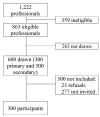Relationship between depressive symptoms, burnout, job satisfaction and patient safety culture among workers at a university hospital in the Brazilian Amazon region: cross-sectional study with structural equation modeling
- PMID: 35508009
- PMCID: PMC9671242
- DOI: 10.1590/1516-3180.2021.0614.15092021
Relationship between depressive symptoms, burnout, job satisfaction and patient safety culture among workers at a university hospital in the Brazilian Amazon region: cross-sectional study with structural equation modeling
Abstract
Background: Workplaces can be sources of mental distress. In healthcare services, this can also affect patients.
Objective: To assess the prevalence of and factors associated with depressive symptoms, burnout, job satisfaction and patient safety culture and the relationships between these constructs, among healthcare workers.
Design and setting: Cross-sectional study in a university hospital in Manaus, Brazil.
Methods: Randomly selected workers were interviewed based on Brazilian-validated tools. We calculated the prevalence ratio (PR) and 95% confidence interval (CI) of depressive symptoms and burnout using Poisson regression with robust variance; and the β-coefficient of safety culture and job satisfaction using linear regression. Outcome relationships were assessed using partial least-squares structural equation modeling.
Results: 300 professionals were included; 67.3% were women. The prevalence of depressive symptom was 19.0% (95% CI: 14.5; 23.5%) and burnout, 8.7% (95% CI: 5.2; 12.3%). Lack of work stability increased depression (PR = 1.88; 95% CI: 1.17; 3.01) and burnout (PR = 2.17; 95% CI: 1.03; 4.57); and reduced job satisfaction (β = -11.93; 95% CI: -18.79; -5.07). Depressive symptoms and burnout were positively correlated, as also were job satisfaction and safety culture (P < 0.001); job satisfaction was negatively correlated with burnout (P < 0.001) and depression (P = 0.035).
Conclusion: Impermanent employment contracts increased depression and burnout and reduced job satisfaction. Job satisfaction reduced poor mental health outcomes and increased safety culture. Job satisfaction and safety culture were directly proportional (one construct increased the other and vice versa), as also were depression and burnout. Better working conditions can provide a virtuous cycle of patient safety and occupational health.
Conflict of interest statement
Figures
Similar articles
-
Relationship between job satisfaction, burnout syndrome and depressive symptoms in physicians: a cross-sectional study based on the employment demand-control model using structural equation modelling.BMJ Open. 2022 Oct 19;12(10):e057888. doi: 10.1136/bmjopen-2021-057888. BMJ Open. 2022. PMID: 36261241 Free PMC article.
-
The relationship between job satisfaction, burnout syndrome and depressive symptoms: An analysis of professionals in a teaching hospital in Brazil.Medicine (Baltimore). 2018 Dec;97(49):e13364. doi: 10.1097/MD.0000000000013364. Medicine (Baltimore). 2018. PMID: 30544404 Free PMC article.
-
Analysis of relationship of psychosocial factors with patient safety culture in a Brazilian hospital: Study with structural equation modeling analysis.J Healthc Qual Res. 2023 Mar-Apr;38(2):112-119. doi: 10.1016/j.jhqr.2022.06.004. Epub 2022 Aug 20. J Healthc Qual Res. 2023. PMID: 35999167
-
Factors determining safety culture in hospitals: a scoping review.BMJ Open Qual. 2023 Oct;12(4):e002310. doi: 10.1136/bmjoq-2023-002310. BMJ Open Qual. 2023. PMID: 37816540 Free PMC article.
-
The Association Between Professional Burnout and Engagement With Patient Safety Culture and Outcomes: A Systematic Review.J Patient Saf. 2021 Dec 1;17(8):e1307-e1319. doi: 10.1097/PTS.0000000000000519. J Patient Saf. 2021. PMID: 29944601
Cited by
-
The Relationship between Job Satisfaction and Depressive Symptoms among Chinese Adults Aged 35-60 Years: The Mediating Role of Subjective Well-Being and Life Satisfaction.Int J Environ Res Public Health. 2023 Jan 22;20(3):2023. doi: 10.3390/ijerph20032023. Int J Environ Res Public Health. 2023. PMID: 36767389 Free PMC article.
-
Relationship between job satisfaction, burnout syndrome and depressive symptoms in physicians: a cross-sectional study based on the employment demand-control model using structural equation modelling.BMJ Open. 2022 Oct 19;12(10):e057888. doi: 10.1136/bmjopen-2021-057888. BMJ Open. 2022. PMID: 36261241 Free PMC article.
-
Protective and Vulnerability Factors of Municipal Workers' Mental Health: A Cross-Sectional Study.Int J Environ Res Public Health. 2022 Oct 31;19(21):14256. doi: 10.3390/ijerph192114256. Int J Environ Res Public Health. 2022. PMID: 36361136 Free PMC article.
-
Exploring the association between loneliness, work environment, and depressive symptoms: evidence from young Korean workers in the Seoul Metropolitan Area.Front Public Health. 2025 May 30;13:1593957. doi: 10.3389/fpubh.2025.1593957. eCollection 2025. Front Public Health. 2025. PMID: 40520319 Free PMC article.
-
Prevalence and associated factors of depressive and anxiety symptoms among healthcare workers in the post-pandemic era of COVID-19 at a tertiary hospital in Shenzhen, China: A cross-sectional study.Front Public Health. 2023 Mar 20;11:1094776. doi: 10.3389/fpubh.2023.1094776. eCollection 2023. Front Public Health. 2023. PMID: 37020820 Free PMC article.
References
MeSH terms
LinkOut - more resources
Full Text Sources
Research Materials



